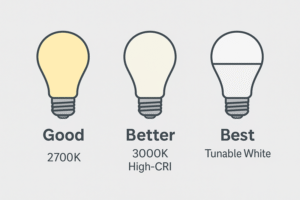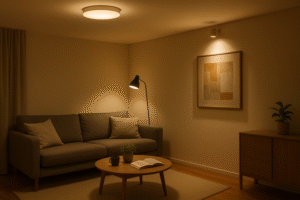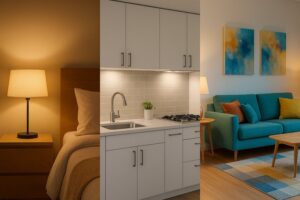You've picked the perfect furniture and colors, but the room still feels flat and lifeless. The wrong lighting can make an expensive, well-planned design fall apart, undermining your entire vision and wasting the investment.
Professional designers use LED bulbs to create layers of light. They combine ambient (overall), task (focused), and accent (dramatic) lighting, using specific color temperatures and decorative bulbs to build depth, mood, and function into any room.
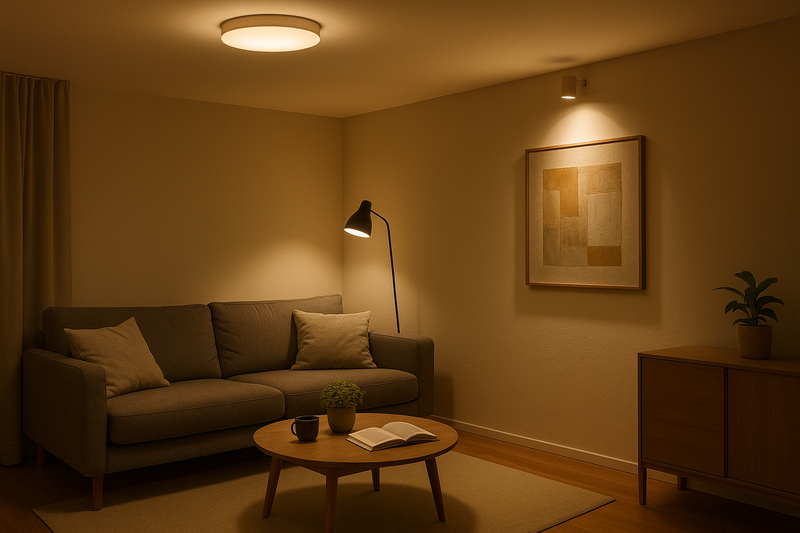
I remember a client, an interior designer from London, who was frustrated with a high-end project. "Wallson," she said, "I have the best materials, but the space feels like a showroom, not a home." The problem wasn't her design; it was her lighting. She was using single, bright downlights everywhere. I explained that great lighting isn't about making a room bright; it's about using light and shadow to create a feeling. We worked together to select bulbs that would create different layers and moods. This experience taught me that for our customers—the buyers and product managers who supply these designers—understanding these techniques is crucial. You're not just selling a light bulb; you're selling a tool for creating atmosphere.
What is the "Layering" Technique in Lighting?
You install one bright, central light fixture in a room, thinking it will be enough. But this creates harsh shadows and a single, boring mood, making the space feel flat and unwelcoming for different activities.
Layering is the design practice of using three distinct types of lighting in one space. It combines general ambient light for visibility, focused task light for activities, and dramatic accent light to highlight features, creating a rich and versatile environment.

This is the most fundamental principle in all of lighting design. A single light source can never serve all the needs of a single room. A kitchen, for example, needs to be a bright workspace for preparing food but also a comfortable, relaxed space for sharing a meal. Layering allows you to achieve this. By putting each layer on a separate switch or dimmer, you give the user complete control over the room's function and feel. As a manufacturer for over 30 years, we've designed specific bulbs to excel in each of these roles. For our B2B clients, like a product manager in the Netherlands, understanding how to recommend bulbs for each layer is a huge value-add for their own customers. It moves the conversation from price to a complete lighting solution.
The Three Essential Layers of Light
| Layer | Its Purpose | How to Achieve It | Recommended Omita Bulbs |
|---|---|---|---|
| Ambient1 | Provides overall, general illumination. The foundation of light in a room. | Ceiling fixtures (chandeliers, flush mounts), recessed downlights. | A60/A19 bulbs, G9 bulbs in multi-socket fixtures. |
| Task2 | Focused, brighter light for specific activities like reading, cooking, or grooming. | Under-cabinet lights, desk lamps, vanity lights, pendant lights over an island. | High-lumen G9 or G4 bulbs, directional spotlights. |
| Accent | Adds drama and highlights specific features like artwork, plants, or architecture. | Track lighting, picture lights, spotlights aimed at a wall. | LED filament bulbs in decorative sconces, narrow-beam spotlights. |
How Can LEDs Make a Small Room Feel Bigger?
You're trying to design a small office or bedroom, but it feels cramped and enclosed. Using the wrong lighting can emphasize the small dimensions, making the space feel even more claustrophobic and uncomfortable for the user.
To make a small room feel bigger, use light to erase the corners and draw the eye upward. Techniques like wall washing, uplighting, and using a single, consistent color temperature create an illusion of spaciousness and airiness.
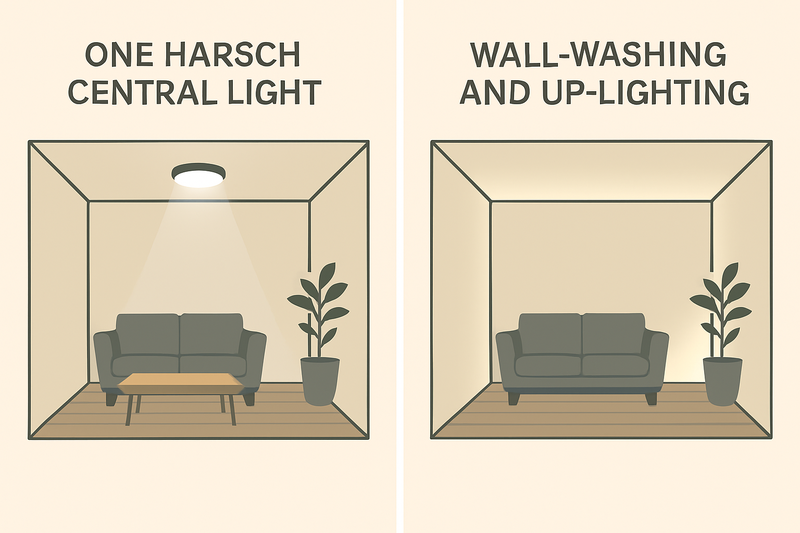
Light is a designer's most powerful tool for manipulating the perception of space. Our eyes are naturally drawn to the brightest point in a room. If that point is a single fixture in the middle of the ceiling, the darker walls feel like they are closing in. By changing where you place the light, you can completely reshape the room. As an exporter to over 85 countries, we've seen designers use these simple but effective tricks everywhere. It's about psychology. Lighting vertical surfaces makes them feel further away. Lighting the ceiling makes it feel higher. These techniques don't require expensive or complex fixtures; they just require a clear strategy and the right bulbs. Offering bulbs in a consistent 3000K or 4000K allows designers to execute these strategies flawlessly, which is a key consideration for any product buyer.
Techniques for Expanding a Space
- Wall Washing3: This is the technique of placing light close to a wall and directing it downward to create a smooth, even wash of brightness. This eliminates shadows in the corners where walls meet, visually pushing the walls outward.
- Uplighting4: Placing lights on the floor or in sconces that direct light toward the ceiling draws the eye up. This creates a sense of greater height and openness, which works wonders in rooms with low ceilings.
- Mirrors and Strategic Placement: Placing a lamp in front of a mirror doubles the light and creates an incredible sense of depth. This is a classic designer trick that makes any space feel larger and more dynamic.
When Should the Bulb Itself Be the Centerpiece?
You traditionally think of a light bulb as something to be hidden inside a fixture. This approach misses a huge opportunity to add character, as you are ignoring one of the most visible elements of your lighting design.
The bulb should be the centerpiece when it's used in an open or exposed fixture. Decorative LED filament bulbs, with their visible "filaments" and unique shapes, are designed to be seen and appreciated as part of the decor.
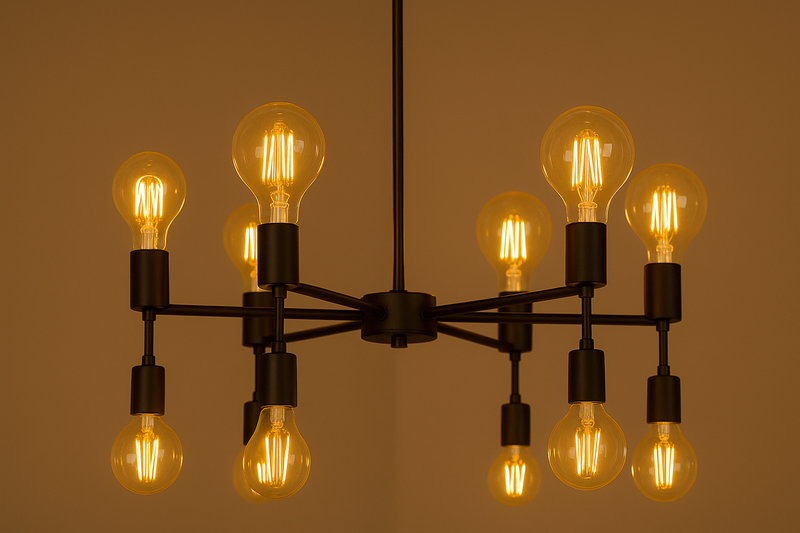
For years, the goal was to hide the light source. But the rise of industrial, farmhouse, and mid-century modern design styles has completely changed this. Now, the bulb itself is a key decorative element. This trend is exactly why we put so much focus on perfecting our LED filament bulbs. We craft them not just to produce beautiful light, but to be beautiful objects in their own right. This is where a manufacturer's attention to detail becomes critical. The shape of the glass (like our classic ST64 teardrop or globe G95), the color temperature of the light (our popular 2200K vintage amber glow), and the design of the internal filaments all contribute to the overall aesthetic. For a project manager or a design-focused buyer like my customer Jacky, having access to a portfolio of beautiful, reliable filament bulbs is essential. They allow a designer to add instant character to a restaurant, hotel lobby, or home with a simple, cost-effective choice.
How Do Dimmers Elevate a Design?
You install a beautiful lighting scheme, but it's static. The light that's perfect for a lively dinner party is far too bright for relaxing afterward, making the space feel functionally "one-size-fits-all" and lacking in sophistication.
Dimmers elevate a design by introducing flexibility. They allow a single lighting layer to have multiple moods, transforming a room's atmosphere instantly. A bright workspace can become a cozy lounge with the turn of a knob, making the design dynamic.
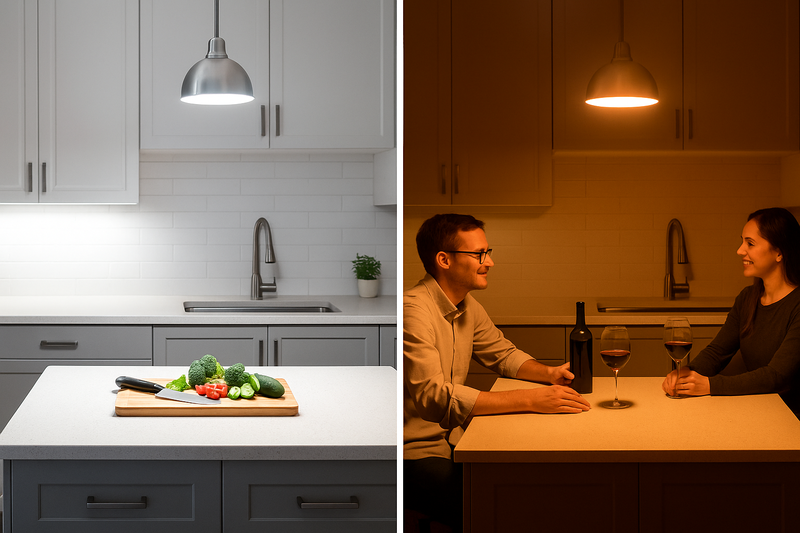
Dimmers are the key to unlocking the full potential of a layered lighting design. They are the difference between a static installation and a living, breathing environment. By allowing the user to adjust the intensity of each layer independently, you give them the power to paint with light. For example, in a living room, you can have the ambient light dimmed to 30%, the accent light on the artwork at 80%, and the task reading lamp at 100%. This creates a visually rich scene that is impossible with simple on/off switches. However, as any buyer knows, the biggest pain point here is quality. Cheap LEDs and incompatible dimmers lead to terrible flickering and buzzing. This is why we focus so heavily on our driver technology at Omita. We ensure our dimmable bulbs provide smooth, silent, and consistent dimming. For a business owner, providing a reliable dimmable solution isn't just a feature; it's a promise of quality that builds trust with your clients.
Conclusion
Master interior design by layering light, choosing decorative bulbs, and using dimmers for control. These LED techniques move beyond simple illumination to create atmosphere, function, and true-to-life color.
-
Understanding ambient lighting is crucial for creating a well-lit, inviting space. Explore this link to enhance your design skills. ↩
-
Choosing the right task lighting can significantly improve functionality in your space. Discover expert tips to optimize your lighting. ↩
-
Discover how Wall Washing can transform your space by eliminating shadows and enhancing brightness. ↩
-
Learn how Uplighting can create an illusion of height and openness, perfect for small rooms. ↩



